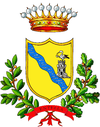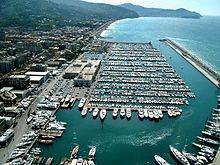Lavagna
| Lavagna | ||
|---|---|---|

|
|
|
| Country | Italy | |
| region | Liguria | |
| Metropolitan city | Genoa (GE) | |
| Coordinates | 44 ° 19 ′ N , 9 ° 20 ′ E | |
| height | 6 m slm | |
| surface | 13.7 km² | |
| Residents | 12,561 (Dec. 31, 2019) | |
| Population density | 917 inhabitants / km² | |
| Post Code | 16033 | |
| prefix | 0185 | |
| ISTAT number | 010028 | |
| Popular name | Lavagnesi | |
| Patron saint | Madonna del Carmine | |
Lavagna ( Ligurian Lavàgna ) is a city with 12,561 inhabitants (as of December 31, 2019) in the metropolitan city of Genoa .
geography
The Ligurian city is located on the coast of the Riviera di Levante . Geographically, Lavagna is separated from the nearby municipality of Chiavari by the Entella River , which flows into the sea between the two cities.
In 2007 the city was awarded the Bandiera Blu (the Blue Flag ) for the particularly good quality of its beaches and the high standard of bathing water quality.
The municipality is part of the Tigullio geographical zone .
climate
The municipality of Lavagna is classified under climate category D , as the degree day number has a value of 1552. This means that the heating period regulated by law in Italy is between November 1st and April 15th for 12 hours per day.
history
Like many Ligurian villages, the village was formed during the Roman Empire under the name Lavania . This name remained unchanged for several centuries until it finally transformed into Lavagna .
Lavagna, which is a by local sources County of Carolingian was, is to 1198 the stronghold of the feudal family Fieschi been what always clashes with the Republic of Genoa has caused. Starting from this place, the Fieschi created their own empire in Liguria by means of their geographical and political sovereignty. During the Middle Ages there were increasing political disputes over the domain in the Levant and the Genoese Doria family soon turned out to be the strongest adversary of the Fieschi . However, when the village became an autonomous municipality in the 12th century, the Fieschi kept administrative and political power in their hands.
In 1564 the small town was attacked and plundered by the Turkish pirate Dragut , just as the surrounding communities had previously been plundered by the Saracens . In 1815 the municipality was subordinated to the Kingdom of Sardinia , as decided at the Congress of Vienna in 1814. In 1861 Lavagna was finally incorporated into the United Kingdom of Italy.
Population development

economy
The municipality's economy is based on tourism , with an emphasis on beach vacations. The coastal district of Cavi di Lavagna has a high influx of beach holidaymakers (also from the surrounding communities), who come on the one hand because of the large number of (paid) beach facilities and on the other hand because of the excellent quality of the beaches.
Personalities
- Giulio Sanguineti (* 1932), Roman Catholic bishop, was born in Lavagna
Individual evidence
- ↑ Statistiche demografiche ISTAT. Monthly population statistics of the Istituto Nazionale di Statistica , as of December 31 of 2019.
- ↑ a b Bandiera Blu 2007 ( Memento of the original from February 14, 2008 in the Internet Archive ) Info: The archive link was inserted automatically and has not yet been checked. Please check the original and archive link according to the instructions and then remove this notice.
- ↑ Confedilizia.it ( Memento of the original from May 20, 2011 in the Internet Archive ) Info: The archive link was inserted automatically and has not yet been checked. Please check the original and archive link according to the instructions and then remove this notice.


